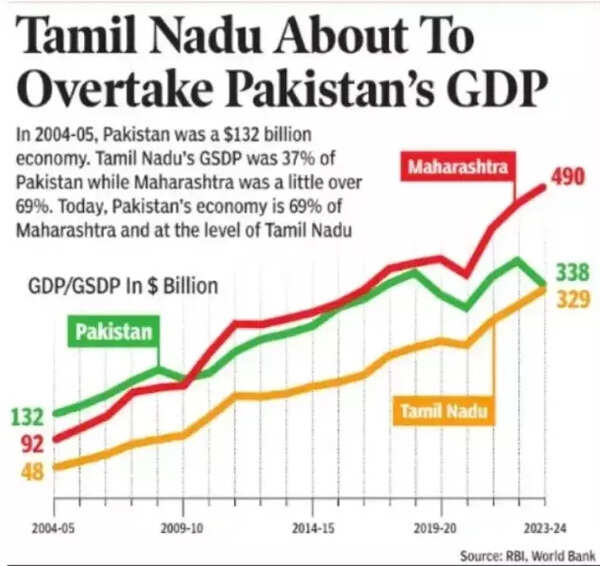Economy in the economy, the Indus Water Treaty Blow of India, India’s: Can Pakistan avoid ‘begging bowls’?

Pakistan probably does not want to go into the world with ‘begging bowls’, but the fact is that its economy is strictly stranded. During a recent address, Pakistan Prime Minister Shahbaz Sharif accepted the very poor economic situation of the country and emphasized that the world does not want him to come up with ‘begging bowls’. He said that Pakistan needs to focus on international investments rather than financial assistance.However, it is not new for Pakistan to demand a bailout package. It has a long history to reduce loans and funds from external institutions and countries and to improve its economic indicators. Recently, the National Accounts Committee of Pakistan said that the country’s GDP’s growth decreased from official estimates for FY 2024-25, leading to only 2.68 percent compared to the target 3.6 percent.Pakistan’s economic reform is critical as it works under the $ 7 billion International Monetary Fund Program. The terms of this financial package require structural changes including electricity rate and additional taxation measures.Also read Explained in the chart: India soon to become the 4th largest world economy. What is the road ahead of No.3 Spot?Pakistan aims to receive $ 4.9 billion of external commercial funds during the financial year 2025-26. The government aims to secure $ 2.64 billion in short -term commercial bank borrowings.Pakistan’s economy faces many challenges and risks, and posts India’s punitive measures, the Pahgam terror attack is not making it easy for Islamabad to be strong.Indus Waters Treaty showing the blow effectThe agricultural sector, which provides employment to about 40% of the labor force, is facing adequate disturbances to suspend India’s Indus Water Treaty.The duration of Kharif (summer crops) planting in Pakistan faces important challenges due to severe low water levels on its important dams – Mangala on the Indus River and Mangala on the Tarbela River. Additionally, after the Pahalgam terrorist incident, there has been a sudden decrease in the flow of the Chenab River after India’s water regulation. The water crisis may deteriorate during the initial kharif sowing of this month. According to the recent data from Pakistan’s Indus River System Authority (IRSA), there is currently a decrease of 21% in water flow in the country, while two primary dams show a decrease of about 50% in live storage. These dams are important for irrigation for hydroelectric power generation along with Punjab and Sindh provinces of Pakistan.According to a TOI report, the recent assessment of the IRSA of water availability for summer sowing during May-sept exposed concerns about low water flow in the Chenb River in Marala, blaming it for India’s limited supply, which will affect the operation of the initial kharif season.Also read India’s big crack! 20 export houses under scanner for illegal Pakistan trade using the UAE route; Business-based money laundering suspectThe authority announced 21% of overall deficit and directed reservoirs management and irrigation monitoring bodies to carefully manage water resources with storage facilities, given the “crisis created by the Indian small supply in the Chenab River”.The monsoon in the catchment area can improve the potential conditions by next month, Pakistan’s agricultural activities will be greatly affected by the management of India’s water flow, which is located on the chainb in the water flow through its limited storage facilities – Baglihar and Salal – Jammu -Kashmir.

About Tamil Nadu about Pakistan’s GDP
Officials believe that the suspension of India’s Indus Water Treaty can greatly affect Pakistan’s ability to handle flood conditions during the period of extreme flow when the monsoon affects the catchment areas of the Indus river system with a sufficient part located within India. Agricultural activities in Pakistan’s Punjab and Sindh provinces are completely dependent on irrigation channels connected to the Indus river network, which receive almost all water from Western rivers – Indus, Jhelum and Chenb.Targeting Pakistan’s funding sourcesIndia aims to ban Pakistan’s money in ongoing efforts against state-propelled terrorism from across the border. Following the protest against Pakistan’s IMF bailout package, India also intended to challenge the upcoming World Bank loans for Pakistan.In addition, India’s intention is the Financial Action Task Force (FATF), Global Financial Crime Watchdog, which demands Pakistan a return to its ‘gray list’.In 2022, Pakistan’s exit from the FATF gray list improved its credibility with financial institutions, which was important for its economically challenging situation. If FATF puts Pakistan back to the ‘gray list’, it will make it more difficult for the country to get investment.Also read ‘Big Bain’ action: How India like Pakistan and its allies – Türkiye and Azerbaijan – are the top 5 remediesIMF strong warning to PakistanEven when this agrarian struggles, Pakistan has been issued a strong warning by the IMF on its bailout package. The IMF has greatly increased the pre -debt programs for Pakistan. The IMF has continued 11 new terms for Pakistan, which has secured continuous financial assistance, including passing 17.6 trillion federal budgets with IMF targets by June 2025 and implementing agricultural income tax reforms in all provinces.Other major requirements include publishing a governance reform plan, formulating a long -term financial sector strategy, rebuilding power tariffs by July and adjusting gas tariffs by February 2026. The IMF also demands a permanent law for a captive power levy, to remove the CAP on a loan servicing surcharge, used in 2035, which uses tax-based form in 2035, which can be done in 2035. spend.




